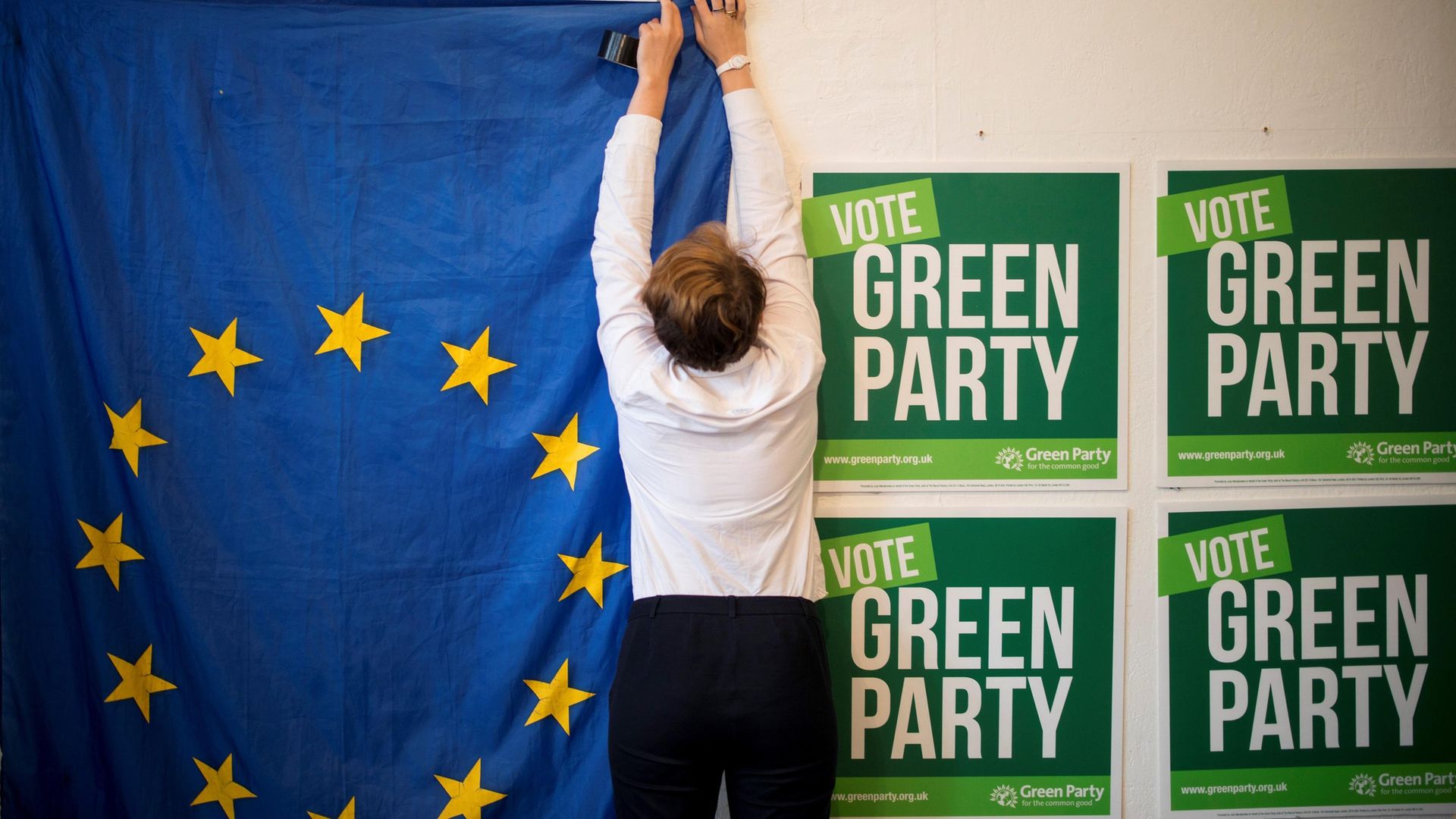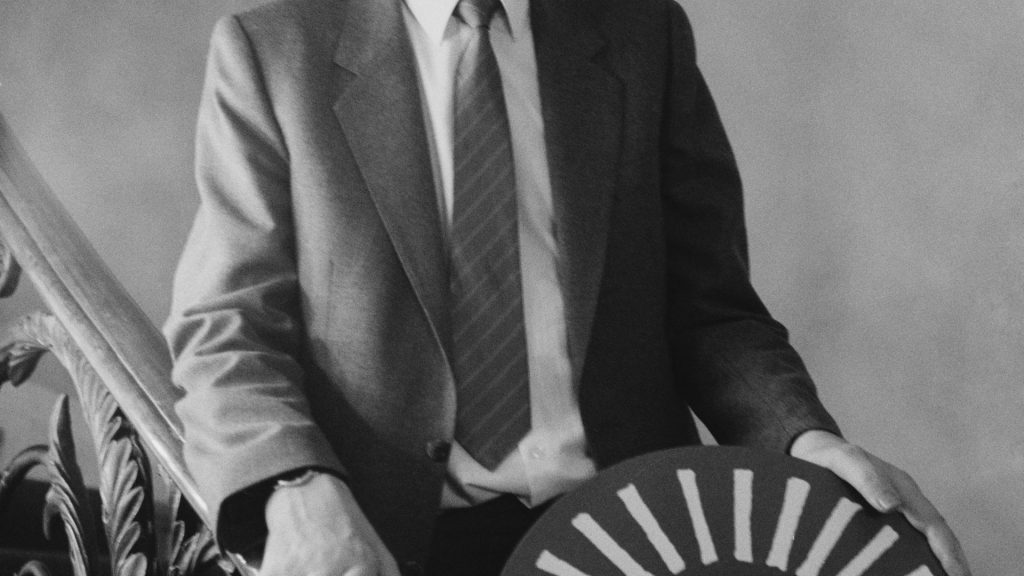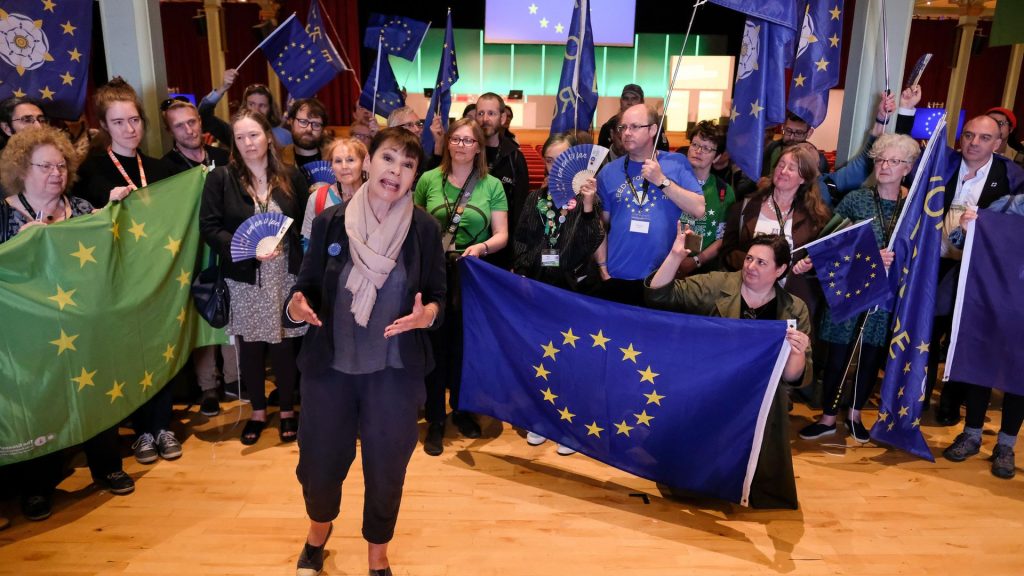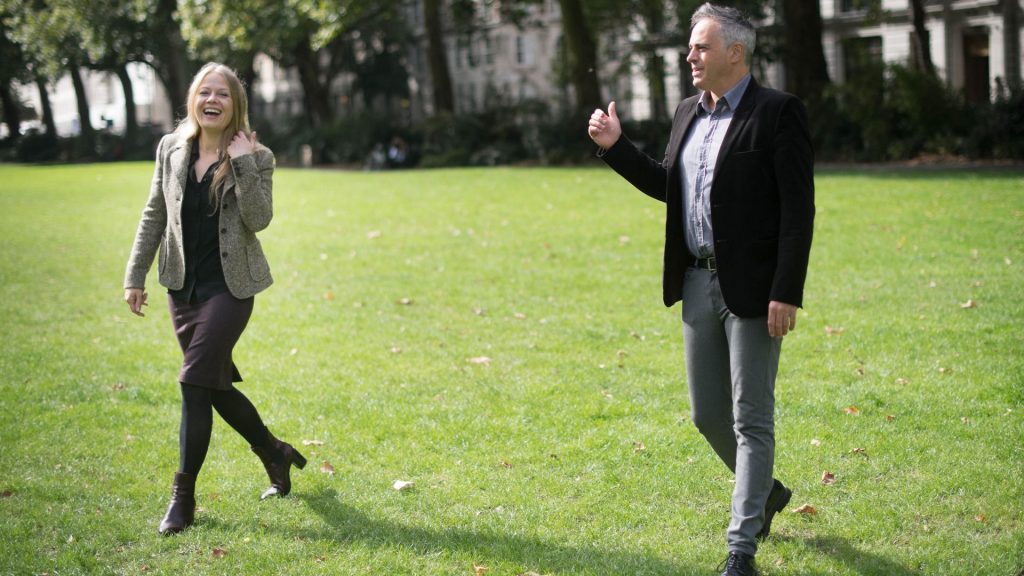
A party supported by Nigel Farage has just won millions of votes in a European election standing on a strongly Eurosceptic platform. However this party wasn’t UKIP or the Brexit Party but the Greens. And the year was 1989.
The Green Party received 2.3 million votes in that election – including Farage’s – representing a 15% share and third place (even if the first-past-the-post system then in operation gave them no MEPs) – a feat they achieved despite not even having a leader. The party’s most recognisable figure at the time was a former footballer and TV presenter, David Icke.
Three decades on and 2019 saw the Greens fare well in another European election, returning seven MEPs (up from two in 2014), with a 12% share of the vote. At the general election later the same year they received more than 800,000 votes and increased their share on an otherwise bad night for progressive parties. They held Brighton Pavilion while finishing a creditable second in Bristol West and Dulwich and West Norwood.

However, much had changed in the intervening 30 years. After his flirtation with environmental politics, Farage became the figurehead for Britain’s Eurosceptic movement and no friend of the Greens – he once said if they won an election “we’d all be living in caves”. Indeed, he later explained that he had voted for the party in 1989 because its strong anti-Brussels stance at the time was the closest to his own views – thus underlining that by far the biggest transformation in the last 30 years has been in the Green Party itself.
In the 2016 referendum, the Greens supported Remain and afterwards campaigned for a second referendum, their sole MP and sometime leader, Caroline Lucas, becoming a key figure in the People’s Vote movement. In last December’s election, it stood on a platform of continued EU membership under a ‘Unite to Remain’ pact with Plaid Cymru and the Liberal Democrats.
So why had the Greens’ view of Brussels changed? What made them lose Nigel Farage’s vote and become one of Britain’s most enthusiastic supporters of the EU?
To understand their current Europhilia, you must first understand their earlier Europhobia. In their 1987 general election manifesto the Greens outlined their opposition to the then European Economic Community on the basis of a fear of domination by large scale corporate and governmental entities. These were similar concerns to those felt at the time by those other former Eurosceptics who have since turned pro-European, Sinn Fein and, to a lesser extent, Plaid Cymru and the SNP.
According to the manifesto, greater levels of centralisation through the EEC were likely to negatively affect the environment, while involvement “in the common market” would marginalise poorer areas causing “social, economic and environmental disintegration”. The Greens argued instead for greater localised community political involvement.
Much of their antipathy to the EEC was based on the Greens’ dislike for the Common Agricultural Policy, which they argued would harm animals and the environment through intensive farming techniques, unhealthy food production and a “ludicrous” pricing system.

Green Eurosceptism of the time was also driven by the wider international politics of the Cold War era. Although the Greens had no desire to be dominated by the USSR they were suspicious of and resistant towards American influence, and in a similar way to Labour Bennites of the 1980s were also opposed to Nato, no doubt influenced by the Greenham Common protests against nuclear weapons.
Indeed, the Green’s anti-nuclear stance was one of the factors behind their powerful showing in the 1989 election. The prominent political scientist John Curtice has put the Greens’ impressive result – which would have given them 12 seats under a proportional representation system – down to a post-Chernobyl alarm about the environment, as well as the spectacular collapse of the Liberal-SDP Alliance. An ineffective Labour Party, the declining popularity of Margaret Thatcher and opposition to the Poll Tax were also factors.
For all that, Eurosceptism was a major part of the Greens’ policy platform in 1989. In their election broadcast they highlighted the “invisible men” of the EEC who they argued had no democratic accountability and were helping “multinational companies use more of the world’s resources”. The party was unable to maintain the momentum of its success, though. It was not helped by a split from the UK party into different parties, reflecting England and Wales, Scotland and Northern Ireland in 1990.
Throughout the following decade the Greens reinforced their opposition to the Maastricht Treaty, the single currency and the single market. But such preoccupations were gradually fading. The 1990s saw a range of new, environmental issues compete for the attention of the Greens. Euroscepticism, meanwhile, emerged increasingly as a force on the right of British politics.
A pivotal moment in the Greens’ journey from Euroscepticism to support occurred with the election of Lucas and Jean Lambert to the European parliament in 1999. Their election – secured, crucially, after proportional representation was introduced – helped raise the profile of British Greens and gave them the experience of working together with other European environmental parties.
It saw them move, incrementally, from being an outsider pressure group to a party with some – albeit minor – influence alongside sister parties in the European parliament, able to influence the increasingly important environmental policies that were emanating from the EU.
The Greens learned their Euro-enthusiasm from experience. In doing so, they were following a similar path previously taken by other European Green groups already in Brussels, who had shifted from opposition to the EU and further integration to a more Europhile and federalist stance.
But it wasn’t just the Greens who were changing. The nature of the EU had changed too. In the era of the EEC, environmental standards tended to be viewed as barriers to free trade. However, following the 1986 Single European Act and pressure from Green NGOs, attitudes began to shift.
Gradually the EU developed better environmental protection and sustainable directives, and increasingly emerged as a force in global environmental politics.
The environmental movement itself was also changing. It had shifted away from its earlier focus on the localised concerns of the 1980s, such as opposition to pollution, development, road building and conservation. By the early 2000s, climate change was coming to dominate all other environmental issues, and it brought with it an obvious need for an international response.
As a result, the Green movement became increasingly international. From Swampy – the protestor who tried to hold up the building of the A30 extension in Devon and the Newbury bypass – the environmental movement was heading towards the era of globe-trotting Greta Thunberg. Of course, it had always had an international aspect – from the earliest days of Greenpeace and Friends of the Earth – but this intensified with the dawning realisation of the threat posed by climate change.
But while the 1999 election of Lucas and Lambert to the European parliament was drawing the British Greens in a new, international direction, it had also underlined another interesting dynamic that would shape its development.
The MEPs were elected in the South East and London constituencies respectively and the party realised that its electoral focus should lie in these two regions.
This in turn pushed it in a more pro-European direction, as the support it drew in these areas was increasingly from middle class, urban voters, where support for the EU was highest. Such a strategy did not mean they could not make inroads in other regions, but when they did it was thanks to urban votes in university cities such as Bristol, Cambridge, Norwich and Sheffield.
However, the Greens’ growing attachment to the EU did not mean it was uncritical. Its 2004 European election manifesto emphasised the ability of the party’s MEPs to change the EU and promote an environmental agenda. In the following year’s general election manifesto they went further, arguing that the EU needed to become more democratic and expressing strong opposition to the European constitution.
Such criticism intensified. In the 2009 European elections the Greens argued that EU institutions were “remote, un-transparent, and undemocratic” with the European Commission being too strong and the European parliament too weak, while in the general election in 2010 there was a pledge to work for “fundamental reform” of the EU.
In 2014, the Greens announced that they would back a referendum on EU membership and campaign to support what would become Remain. However the manifesto for the European elections that year was heavily critical of the domination of corporate lobbying interests in Brussels.
This binary view of Brussels – support for British membership, coupled with deep mistrust – reflects long-running tensions in the Green Party.
It has often been said that it comprises three ideological factions: the ‘deep greens’ (or ‘kiwis’, or ‘limes’), who are green all the way through, and promote a ‘conservative’, traditional form of environmentalism; the ‘watermelons’, who are green on the outside but red on the inside – including many who were previously in socialist or communist parties, or from the Labour left; and the ‘mangos’, who are green on the outside but yellow within – that is, those who are socially-liberal and close to the Liberal Democrats in outlook.
In the early years of the Green movement there was more of a traditional ‘deep green’ emphasis on localism and ecology, which fitted into the Eurosceptic fear of domination by Brussels.
However during the New Labour years – even while the Greens were seeing their first MEPs elected and were being drawn into European environmental politics – the ‘watermelon’ tendency was growing in strength, as many disillusioned ex-Labour members joined. In 2006, the Green Left faction was formed to represent this group within the broader Green movement.
So as the party was becoming established in Brussels and, in many ways becoming more international and pro-European, it was also bringing in others from the left, many with sceptical views of the ‘corporate’ EU. This helped to bring a more critical edge to the Greens ‘soft Euroscepticism’ of the period.
The Conservative-Lib Dem coalition, however, had a dramatic effect on Green politics. This time, it was disillusioned Lib Dem voters (and members) who deserted the party and found a new home with the Greens. Their arrival meant the ‘mango’ tendency grew in influence, thus pushing the party in a more pro-EU direction.
Research in February 2015 estimated that half of those planning to vote Green in the forthcoming election had voted Lib Dem in 2010, while more of them had voted Conservative than Green in 2010.
In terms of key issues, the research found more of these voters placed the economy ahead of environmentalism than vice versa, suggesting that many Greens looked like Lib Dems but thought like Labour voters. The implication of the research was that the Greens were increasingly becoming a left wing party – with policies on a range of issues – rather than a single issue pressure group. The study concluded that Lib Dem and Green voters tended to be university-educated and middle class, working in professional and managerial jobs – a demographic that voted strongly in favour of Remain in 2016.
The Greens’ other significant electoral constituency are among millennials – a generation that is broadly pro-immigration, anti-tuition fees, highly-educated and pro-EU. This demographic swung to the Lib Dems in 2010, the Greens under the coalition then to Corbyn. (The Greens will now be hoping it can win many of them back from Starmer’s Labour.)
These, then, were the forces that drove the Green Party towards its support for Remain in 2016, and which have intensified thereafter. After all, before the referendum, the EU would have been pretty far down the list of priorities for many Greens (voters, members and even politicians). But the chaos that has been unleashed by Brexit has made it an increasingly important issue, and has hardened the Green Party’s pro-European stance since 2016.
However, the Eurosceptical Green strain remains. There were many Green voices advocating for Leave in 2016, among them former archaeologist Baroness Jenny Jones, the party’s only peer in the Lords from 2013 to 2019. (The life peer and first Green in the Houses of parliament Lord Beaumont of Whitley – who died in 2008 – had also been a Eurospectic.)
Jones campaigned against the lack of democracy in Brussels, EU austerity policies imposed on Greece and the proposed US-EU Trans-Atlantic Trade Partnership – an issue that helped steer many Greens away from the EU, amid concerns it would have negative impacts on animal welfare, medicine, digital rights, financial regulation and jobs.
Leslie Rowe – a Green Eurosceptic former European and parliamentary election candidate, and treasurer of the Green Leaves group – stood for the leadership in 2018 arguing that the party’s Remainers had not “yet explained why they want to stay in a corporatist union”.
“We’ve always been a Eurosceptic party even from the days of being the Ecology Party, and what changed was not the party but the leadership of the party,” he told me in a recent interview. “In 2018 there was still a strong contingent of people who were Eurosceptic and the Green Party conference that year decided not to support a fully Remain position. There is still a degree of Eurosceptism particularly among long-standing members”.
Rowe lost in 2018 to Jonathan Bartley and Siân Berry, the co-leaders who signed the party up for the campaign for a People’s Vote. The pair were re-elected to their posts last month and it remains to be seen how they will shape their party’s policy on Europe. It is hard to see how they can repudiate their earlier strong Remain stance, and they might even hope to capitalise on the apparent reluctance of the new Labour and Lib Dem leaders to grasp this issue.

But there will be some in the party who consider that the Greens’ support for a second referendum, and last year’s joint ticket with the Lib Dems, has seen them lose some support and credibility as a radical party, and that a new attitude towards Brussels is needed.
After all, there is a long history of Green Euroscepticism, if not always outright rejection of British membership of the EU. Perhaps through its MEPs it lost some of its status as an ‘outsider’ pressure group and almost became part of the establishment. Did Jeremy Corbyn capitalise on the ‘Green surge’ in 2015 and take over from the Greens as the radical option leaving the party with nowhere to go? Did the Greens get carried away with their positive results in the 2019 local and European elections and think they could ‘stop Brexit’ with the Lib Dems and Plaid?
Arguably the strong Europhile Green tendencies were an aberration between 2017 and 2019 a move away from the party’s traditions of scepticism towards powerful organisations and support for localised, sustainable alternatives.
With Britain although having left the EU and the Eurosceptics who were the plucky anti-establishment outsiders prior to 2016 now the establishment, the Greens might see a chance to present themselves as the radical force in British politics.









